In our data-driven world today, the terms “data scraping” and “data mining” are often used interchangeably; however, they refer to two different processes with separate goals and uses. From a business and individual standpoint, understanding the difference between data scraping vs data mining can be particularly useful for leveraging data for good. In this blog post, we will explain the differences between them so that you can ultimately understand which one suits your needs.
Table of Contents
Introduction: Why the Difference Between Data Scraping and Data Mining Matters
The ability to collect and make sense of data is important in a world filled with data. Knowing the difference between data scraping and data mining is very important; it is not simply semantics, but also a conceptual understanding of the data lifecycle. Data scraping is the process of getting raw data from websites, and data mining focuses on finding knowledge in the data.
In fact, it’s easier to think about the order of operations: a prospector panning for gold has to first collect a large amount of riverbed material (scraping), and then they can find the gold nuggets by filtering out the debris (mining). There is an important conceptual difference between the two processes, and this distinction has an impact on your projects, in terms of your budget, and in the value you can extract from the data.
What Is Data Scraping?
Data scraping, sometimes referred to as data scraping, is an automated method for extracting vast amounts of data from web pages. Rather than manually copying and pasting data, which would take an incredibly long time, data scraping tools use bots to acquire and structure data from the web. This process is beneficial for obtaining publicly provided data that is not easy to analyze due to the format in which it is provided.
As an example, maybe a company will use a LinkedIn Profile Scraper to obtain information about job candidates, or a LinkedIn Company Scraper to obtain information on competitors. These website scraping tools will traverse the pages of a website to find the data points necessary (like names, job titles, or company sizes) and then save this data in a structured format, such as a CSV file or a database.
So, the next time somebody asks you what data scraping is or what is data scraping you can totally answer them!
LinkedIn Profile Scraper - Profile Data
Discover everything you need to know about LinkedIn Profile Scraper , including its features, benefits, and the different options available to help you extract valuable professional data efficiently.
What Is Data Mining?
Data mining involves identifying patterns, trends, and other meaningful responses from masses of data. Data mining explodes it’s understanding as an overarching field leveraging statistics, machine learning, and database systems. The distinction of significance between data mining and data scraping is that scraping mechanisms exist in ways designed to retrieve data for further processing. Data mining isn’t data collection, it is data analysis. Data mining wants to unveil the reasoning behind the children less relevant, and nothing more than meaningless numbers.
To illustrate data mining, supermarkets utilize “market basket analysis.” Supermarkets aggregate large amounts of sales data to understand their customer habits (purchases and trends amongst customers) more broadly using and identifying these purchases and aligning them with purchase patterns.
For example, a supermarket may identify that customers who purchase diapers, may be more likely to purchase beer, which may inform the marketing decision of putting those two items closer together in the store. The difference is again, the data is collected and now, is being analysed.
This process is very technical, and you can learn more about it in this guide on How to Do LinkedIn Data Scraping.
Data Scraping and Data Mining: A Powerful Partnership
Data scraping and data mining are distinct but complementary processes. In many instances, data scraping provides the first step in a data mining project. Data mining cannot happen without first gathering a huge amount of data to mine, and the raw data collected through data scraping can often be messy and unstructured. In order to make it ready for data mining, the data must be cleaned, preprocessed and organized into a structured format.
When the data is prepared for data mining, you can use data mining techniques to extract useful information from the data. For example, a company may scrape customer product reviews from several e-commerce sites, then utilize sentiment analysis (a part of data mining) to provide insight about public sentiment toward those products.
Using what is web scraping vs data mining to ingest content and then analyze the data, it gives businesses the advantage of data-driven decisions based on real-time information taken from the web.
Key Differences Between Data Scraping and Data Mining

To better clarify the debate between data scraping and data mining think of it like this.
Let’s say you’re a chef and want to prepare a new dish. Data scraping would be like going to the market to collect all the raw materials you need to cook. The point is on collecting; you are worried about collecting the freshest vegetables, the right spices, and the best cuts of meat. Your end goal is simply to collect all the materials that you need.
Data mining is the act of cooking. Data mining is what you do back in the kitchen. You take raw materials that you gathered at the market, use them to create a meal. You are analyzing the flavors of the vegetables, applying your cooking techniques, and following a recipe (maybe originally created by you!) to turn raw materials into a dish that is delicious and coherent.
You aren’t just worried about the ingredients; you use them to analyze patterns, relationships and to create value.
That is the fundamental difference between gathering raw materials and creating value through those raw materials. The difference becomes much more apparent when you break it down into different operational distinctions that are in the table below.
To further clarify the distinction, let’s break down the key differences between data scraping and data mining:
| Feature | Data Scraping | Data Mining |
| Primary Goal | To collect raw data from websites. | To discover patterns, trends, and insights from data. |
| Data Type | Primarily unstructured or semi-structured data. | Primarily structured data. |
| Process | Automated extraction of data using bots and scripts. | Statistical analysis, machine learning algorithms, and data modeling. |
| Output | Raw data in a structured format (e.g., CSV, JSON). | Actionable insights, predictions, and reports. |
| Required Skills | Programming (e.g., Python), knowledge of web technologies (HTML, CSS). | Statistics, machine learning, data visualization, domain expertise. |
When Should You Use Data Scraping? Use Cases Explained
Data scraping is the ideal option for obtaining datasets that are not available via an API or downloadable data file. Some common uses for data scraping are:
- Price Tracking: e-commerce businesses can scrape competitor sites to find prices on similar products they sell, and update their pricing strategy accordingly (in real-time).
- Lead Generation: sales and marketing teams can scrape professional social networks to find leads, and get their contact information.
- Market Research: organizations can scrape news articles, forums, and/or social media to better monitor trends and public sentiment in regards to their industry.
- Real Estate: real estate agents can scrape their property listing from all over the web (multiple sources) to create a comprehensive dataset of all properties available for sale.
When Does Data Mining Make More Sense?
When you have a large dataset, and you want to use that dataset to extract information, you will need to use data mining. Here are some examples of data mining applications:
1. Customer Segmentation: Organizations can mine customer data to identify groups and customize their marketing activities to target those groups.
2. Fraud Detection: Banks and credit card companies mine transaction customer data to identify suspicious transactions that fall out of a pattern of normal behavior of a customers account.
3. Medical Diagnosis: Medical professionals mine data to look for trends in patient data, for instance, in predicting the probability of disease.
4. Personalized Recommendations: Data mining can be used to profile user behavior for companies like Spotify and Netflix recommend content.
Beyond the Basics: Advanced Applications of Data Scraping and Data Mining
As technology continues to advance, the uses of data scraping vs data mining have changed. Here are some more creative and advanced use cases:
- Predictive Maintenance: In manufacturing, by scraping data off sensors on machines, we can mine that data to predict failures of machines in the future. This equals proactive maintenance, less downtime and savings of money!
- Urban Planning: City planners can scrape data from social media, and traffic apps to see how people are moving through that city. They can mine that data better to be able to expedite public transportation routes and future infrastructure needs.
Choosing the Right Tool: Data Scraping or Data Mining for Your Goals
The decision on whether to use data scraping software or data mining software will likely come down to what you want to achieve. If you’re trying to gather data from the web, then you need data scraping software. If you have a dataset and want to analyze it to discover hidden insights, then you need a data mining software.
If you want to scrape data from the web and then data mine it for insights, you’ll want to use both data scraping and data mining software. This not a case of data mining vs data scraping being better, but more a case of which you need for your task.
LinkedIn Company Scraper - Company Data
Discover everything you need to know about LinkedIn Company Scraper , including its features, benefits, and the various options available to streamline data extraction for your business needs.
Final Verdict: Data Scraping vs Data Mining
In summary, data scraping vs data mining is really two faces of the same coin. They’re both key features in the data life cycle, but serve different purposes. To put it simply, data scraping is to collect data while data mining is to analyze it. Knowing this difference is the first step to developing a successful data strategy.
Closing Insights: Data Scraping vs Data Mining
Although transitioning from unadulterated data to insights can be difficult, it is a worthy effort. Understanding the difference between data scraping vs data mining will help you effectively use the right tools and follow the right processes to achieve your aims. Whether you are a business owner, marketer, researcher, or simply a curious individual when it comes to data, the use of information can provide endless possibilities.
Common Questions on Data Scraping vs Data Mining
1. Is data scraping illegal?
The legality of data scraping can depend on a number of factors including the data you are scraping and the terms of service of the website you are using. Advisedly consulting a lawyer before implementing your data scraping project on a larger scale would be to your benefit.
2. What are the most popular data scraping tools?
There are countless data scraping brands and tools to choose from including open source libraries like BeautifulSoup and Scrapy, paid platforms such as Octoparse and ParseHub, and many more. Depending on your level of expertise as well as how complex your project is will determine what tools you will use.
3. Can you use data scraping and data mining at the same time?
Absolutely! In fact, it can often be the case that data scraping occurs in tandem with data mining! You can scrape the raw data and then use whatever data you collected to populate a data mining tool.
4. What is the difference between data mining and machine learning?
While data mining and machine learning work faculties that are practically very similar in their progression, yet they are entirely different. Data mining pertains to the finding of patterns in data, while machine learning is characterized by a development process in which the certain algorithm uses data to learn and make predictions. Machine learning is also often positioned as the tool of data mining.





